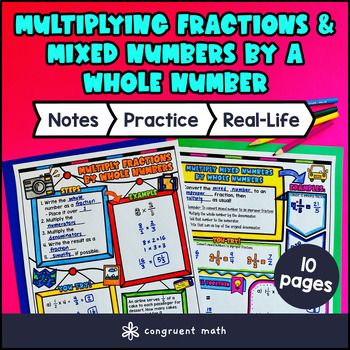Want more ideas and freebies?
Get my free resource library with digital & print activities—plus tips over email.
Join for Free Resources →
$4.25
Ever wondered how to teach multiplying fractions and mixed numbers by whole numbers in an engaging way to your 4th grade students?
In this lesson plan, students will learn about multiplying fractions and mixed numbers, along with their real-life applications. Through artistic, interactive guided notes, checks for understanding, a color-by-code activity, and a maze worksheet, students will gain a comprehensive understanding of this topic.
The lesson culminates with a real-life example that explores how multiplying fractions and mixed numbers applies to everyday situations.

$4.25
After this lesson, students will be able to:
Before this lesson, students should be familiar with:
As a hook, ask students if they have ever shared or doubled a recipe, and how they might figure out the new amounts of ingredients if the recipe calls for fractions of a cup or spoonful. Encourage students to think about why multiplying fractions by whole numbers might be useful in real life. Refer to the last page of the guided notes as well as the FAQs below for more ideas and sample questions.
Use the first page of the guided notes to introduce multiplying unit fractions by whole numbers. Walk through defining unit fractions and demonstrating how repeated addition relates to multiplication of fractions by whole numbers. Highlight key points such as multiplying the numerator by the whole number while keeping the denominator the same, and check for understanding using the embedded questions. Refer to the FAQ below for strategies on addressing common student misconceptions, like confusing numerator and denominator roles during multiplication.
Use the second page of the guided notes to introduce multiplying non-unit fractions and mixed numbers by whole numbers. Guide students through converting mixed numbers to improper fractions before multiplying. Emphasize step-by-step strategies for converting mixed numbers, multiplying, and then simplifying the result. Use the doodles and visual aids on the page to reinforce these concepts. Refer to the FAQ below for detailed explanations on how to clarify when to convert and how to simplify answers.
If students struggle with any of these foundational concepts, provide targeted reteaching either as a group or in small groups depending on class size and needs. For students who show proficiency during the checks for understanding, suggest they start working on the practice worksheet independently while you support those needing extra help.
Have students practice multiplying fractions and mixed numbers by whole numbers using the color by code practice worksheet. Walk around to answer student questions.
Fast finishers can dive into the maze activity for extra practice. You can assign it as homework for the remainder of the class.
Bring the class back together, and introduce the concept of using multiplication of fractions and mixed numbers by whole numbers in real-world scenarios such as cooking, where recipes often need to be scaled up or down. For example, if a recipe calls for 1 1/2 cups of flour and you want to make three times the amount, you multiply 1 1/2 by 3 to find the total flour needed. Refer to the FAQ for more ideas on how to teach it!
If you’re looking for digital practice for multiplying fractions by whole numbers, try my Pixel Art activities in Google Sheets. Every answer is automatically checked, and correct answers unlock parts of a mystery picture. It’s incredibly fun, and a powerful tool for differentiation.
Here’s 1 activity to explore:
Multiplying fractions by whole numbers means finding a product when a fraction is multiplied by a full number without fractions or decimals.
To multiply a fraction by a whole number, multiply the numerator of the fraction by the whole number and keep the denominator the same. Then simplify the fraction if possible.
A mixed number contains both a whole number and a fraction. To multiply it by a whole number, first convert the mixed number to an improper fraction, then multiply as usual.
To convert a mixed number to an improper fraction:
Yes, you can multiply whole numbers by both unit fractions (fractions with numerator 1) and non-unit fractions (fractions with numerator greater than 1) using the same process of multiplying the numerator by the whole number.
After multiplying, simplify the fraction by:
Learning this skill is important because it helps with real-life math applications such as cooking, measuring, and dividing things into parts where quantities involve fractions and whole numbers.
Some fun practice methods include:
Guided notes and doodles help students by:
Get my free resource library with digital & print activities—plus tips over email.
Join for Free Resources →